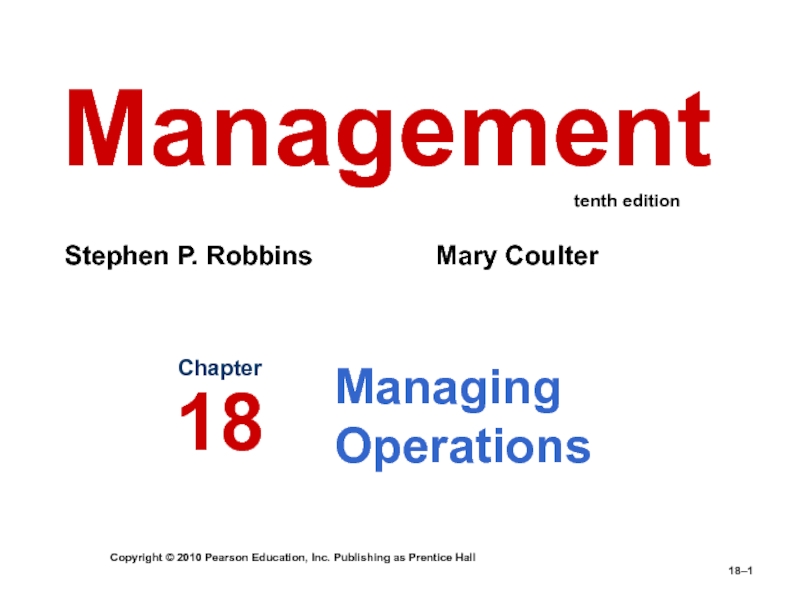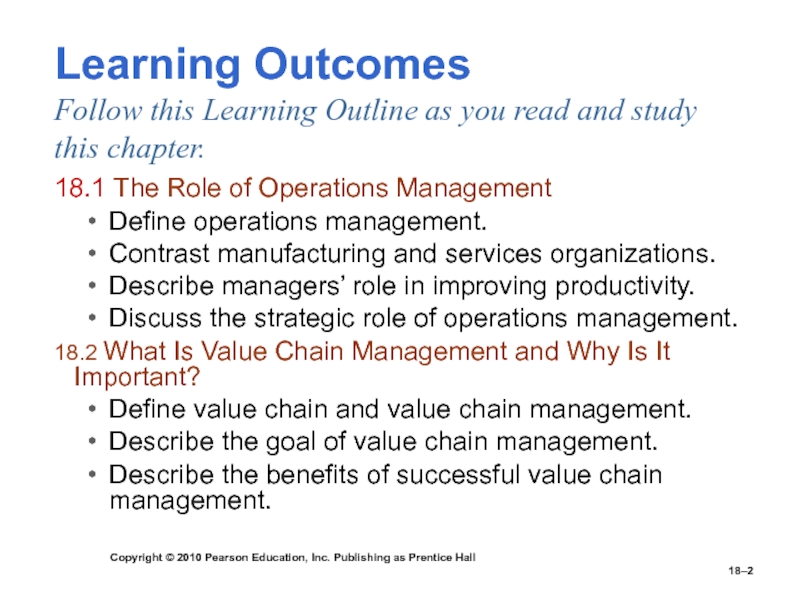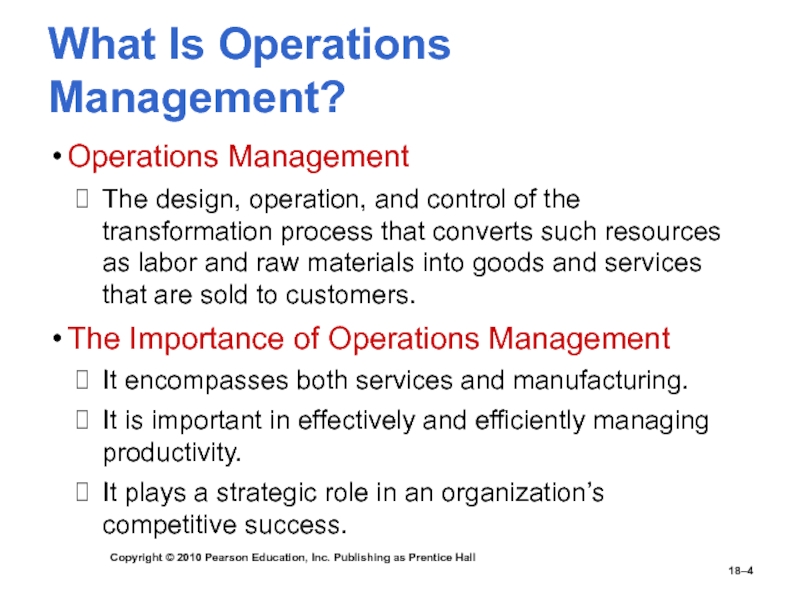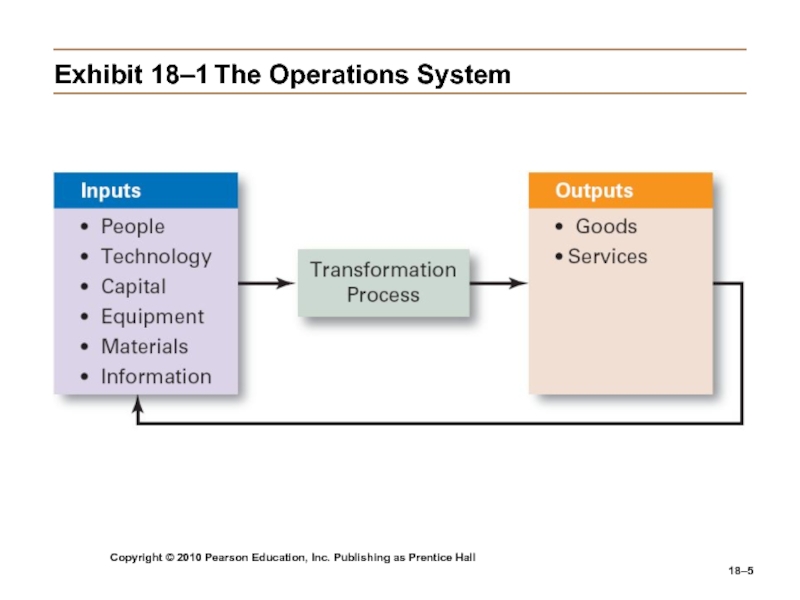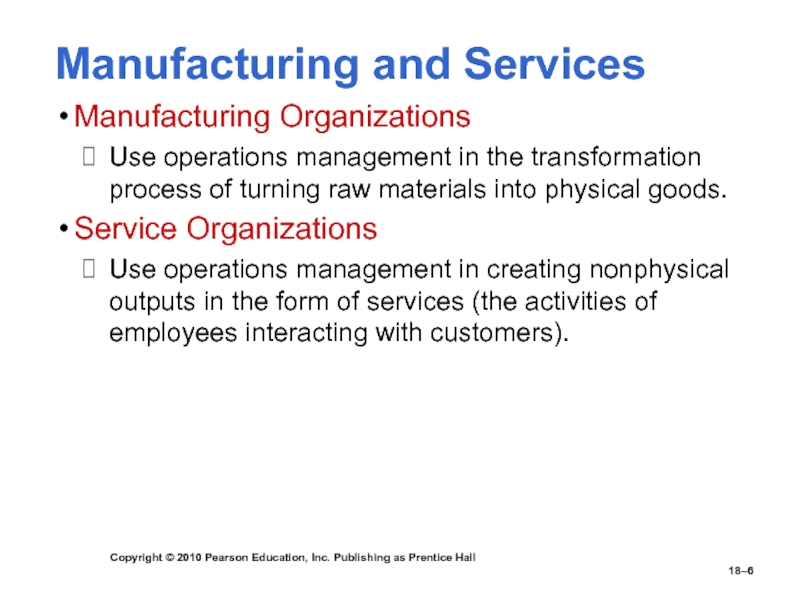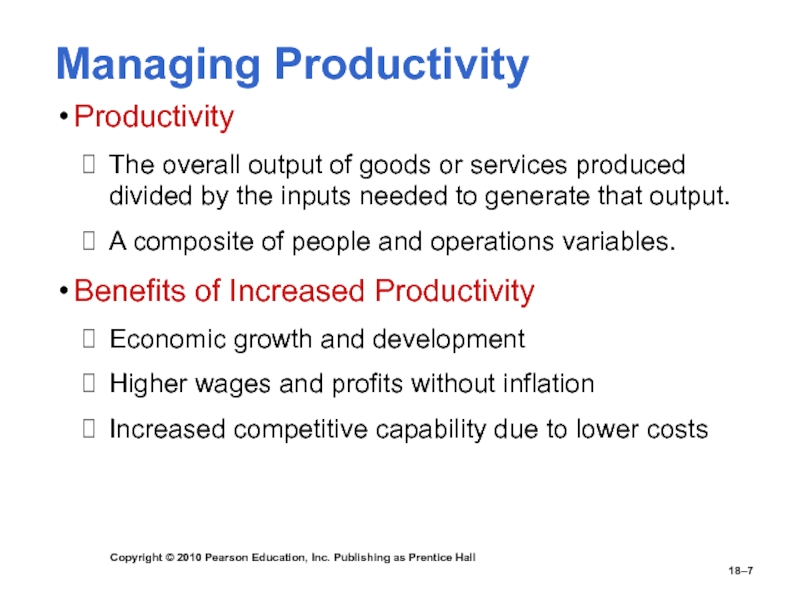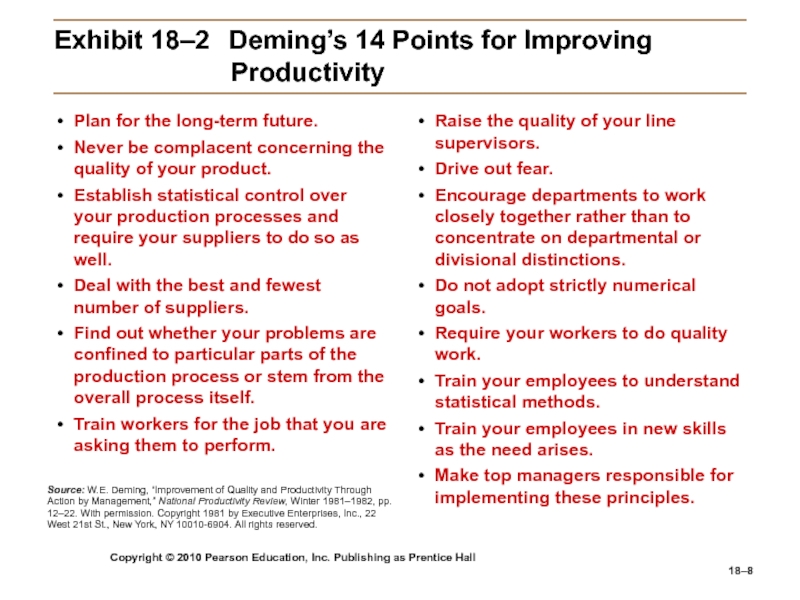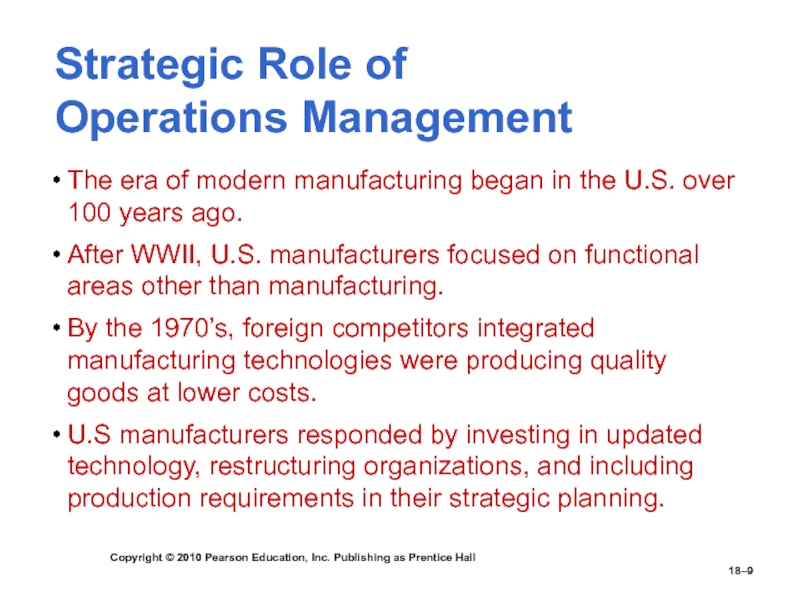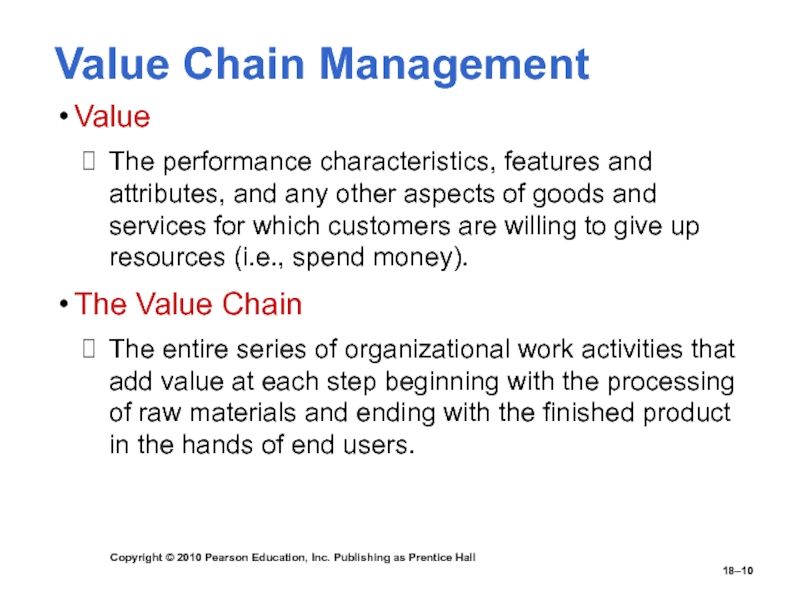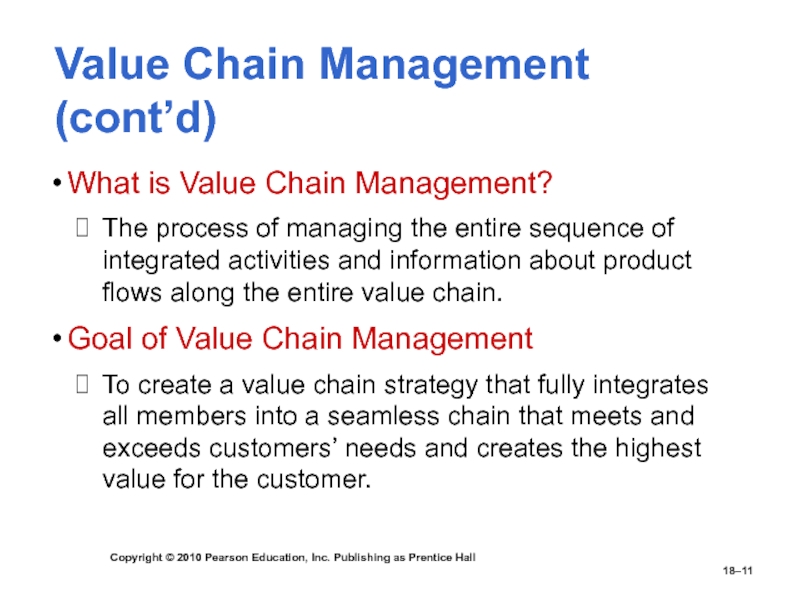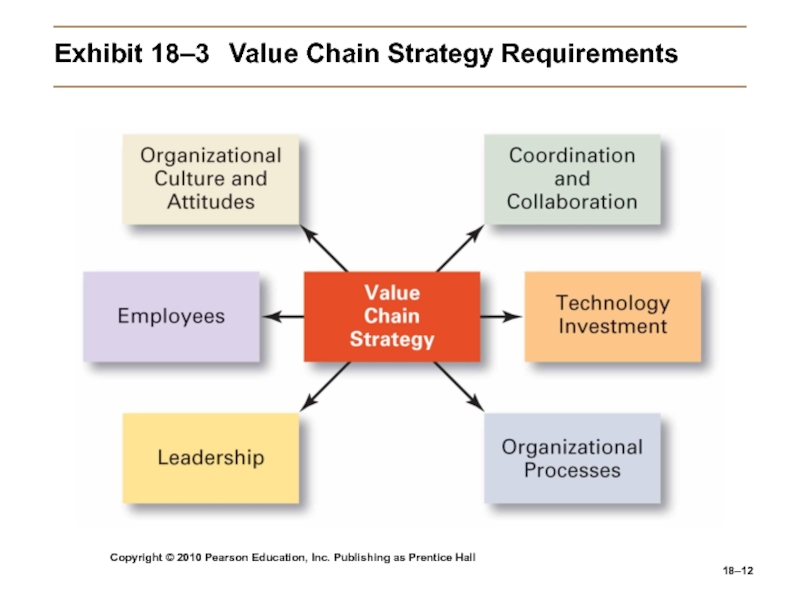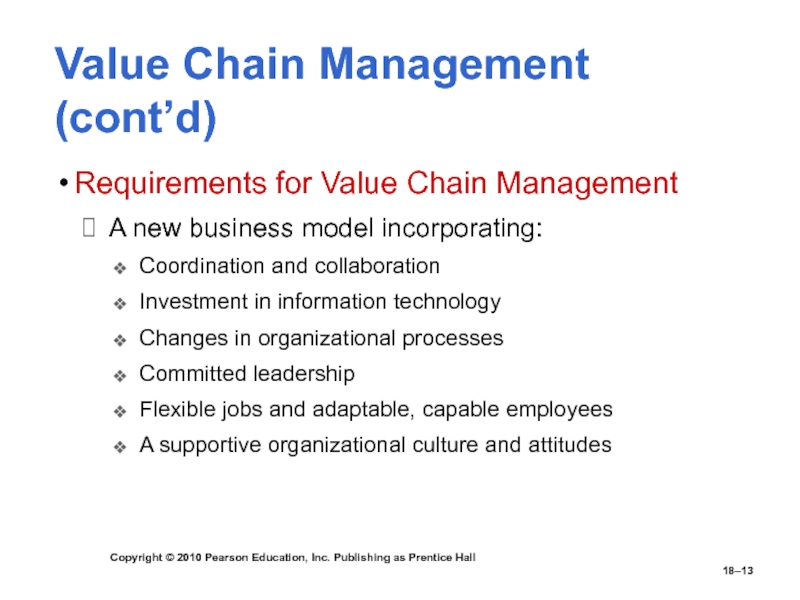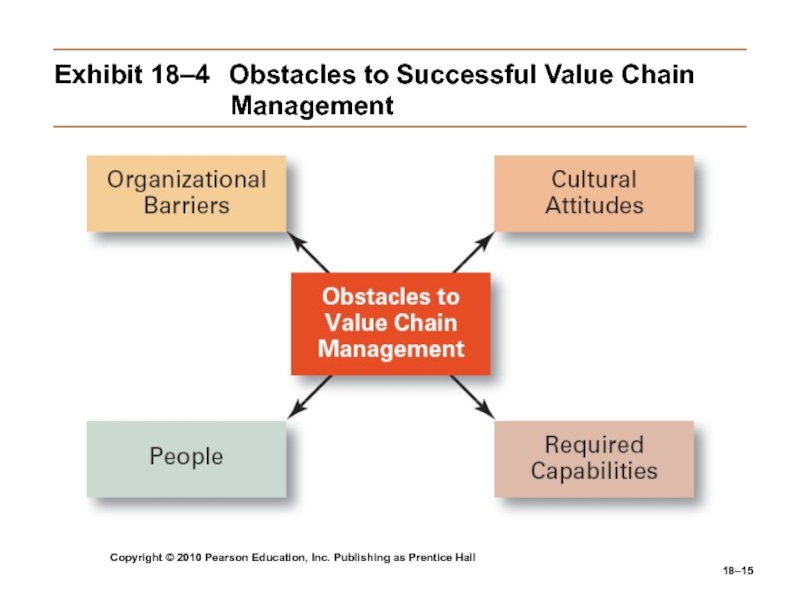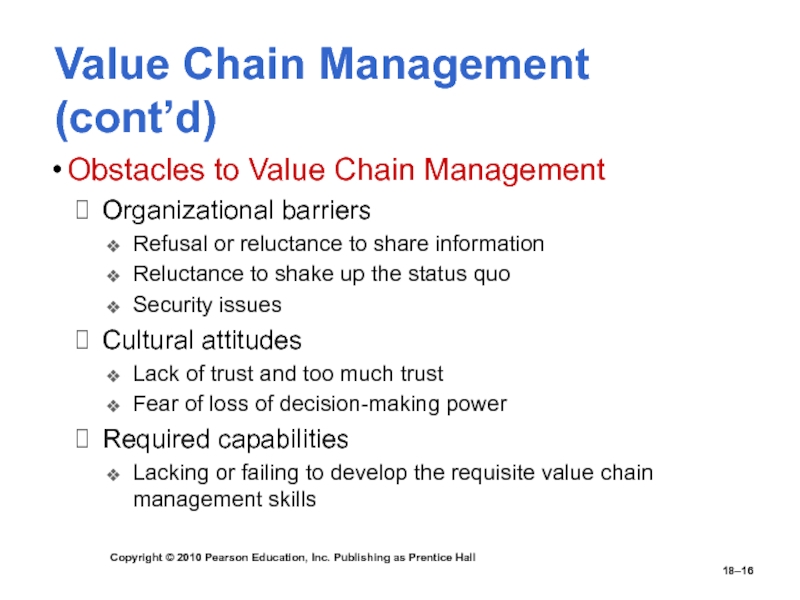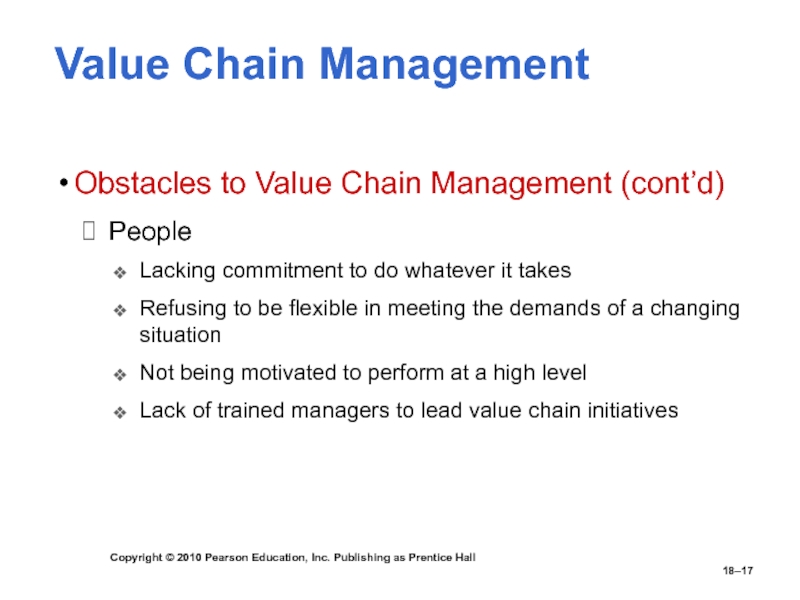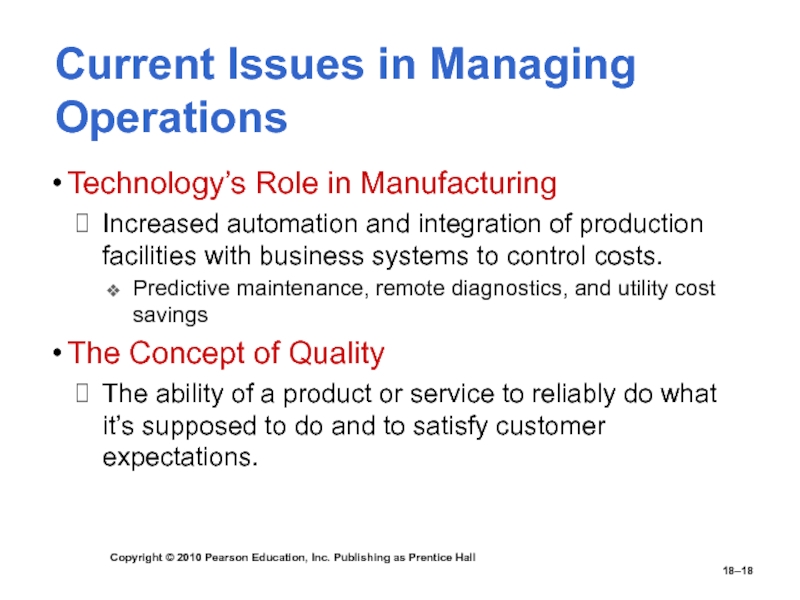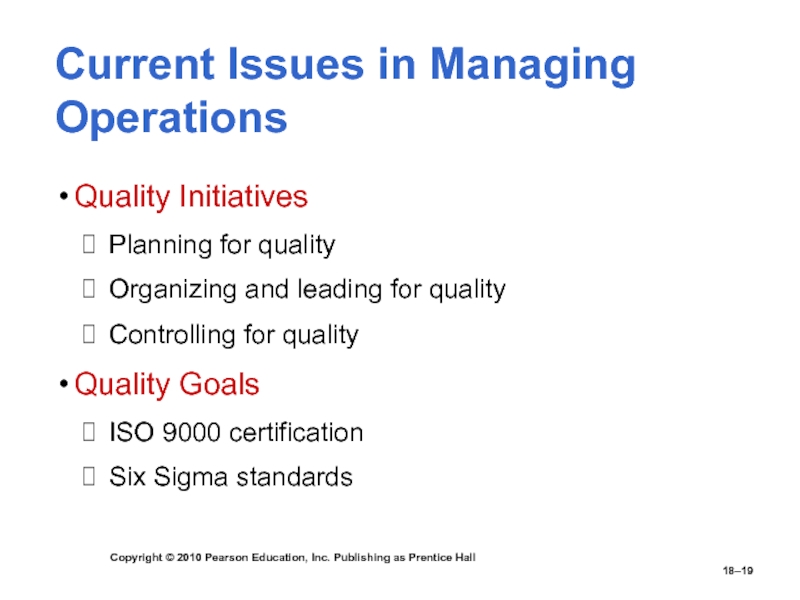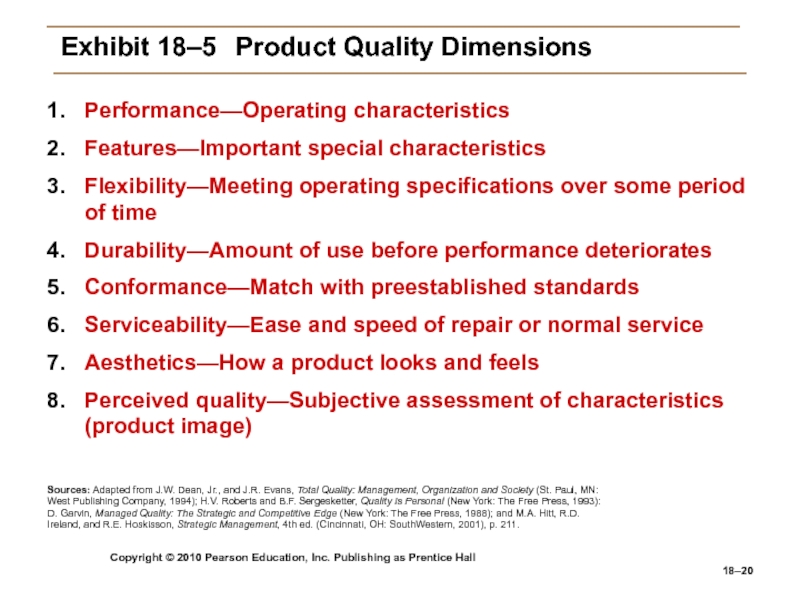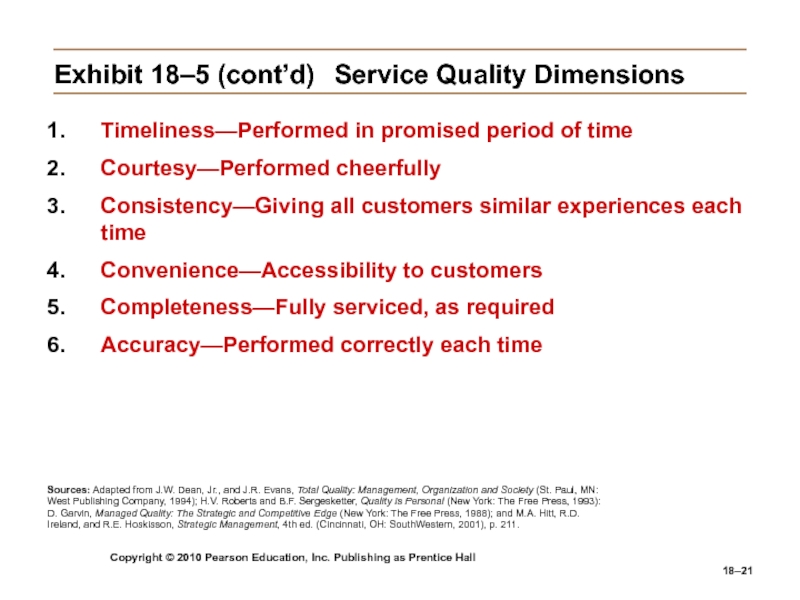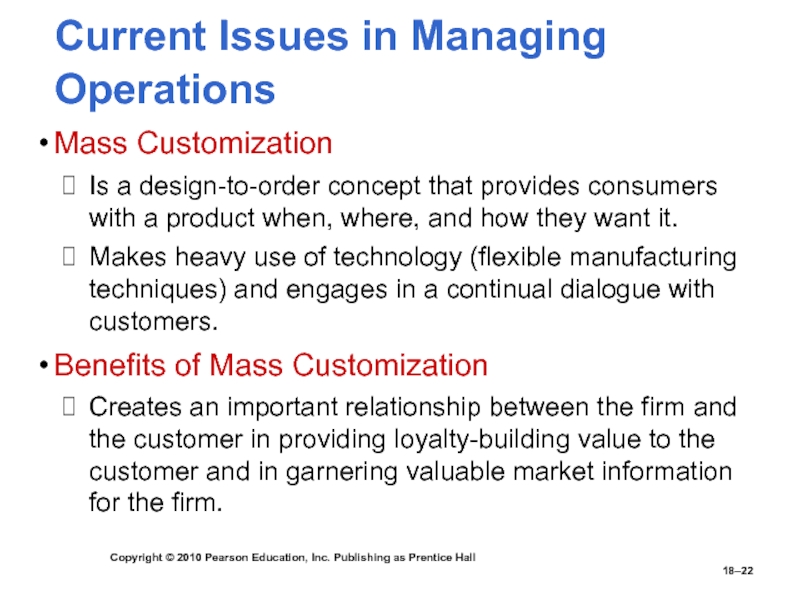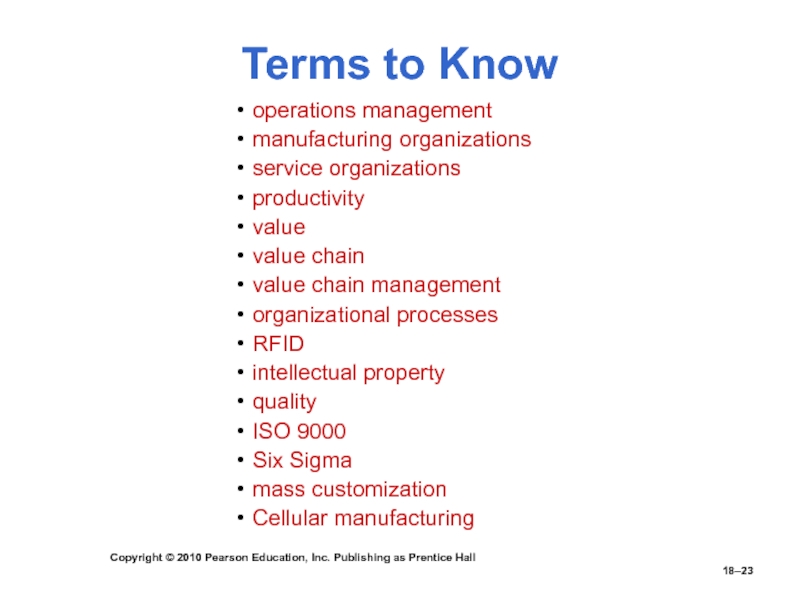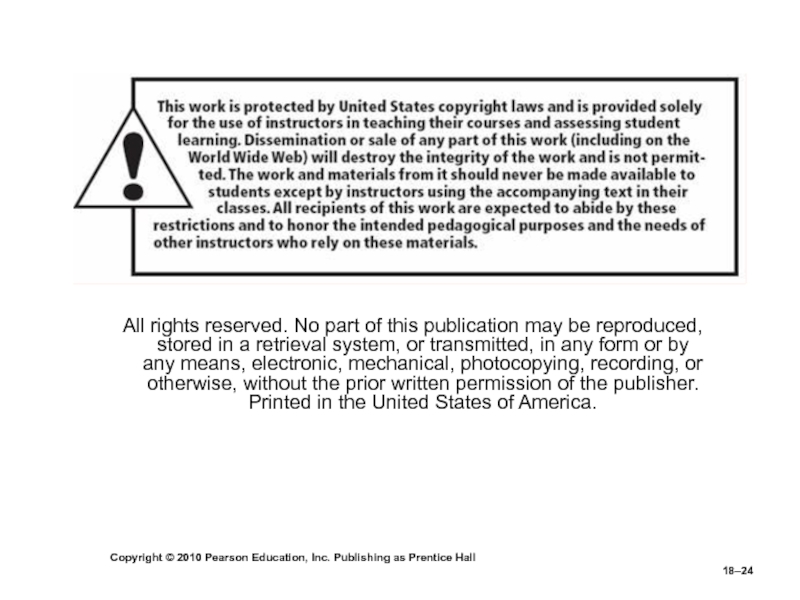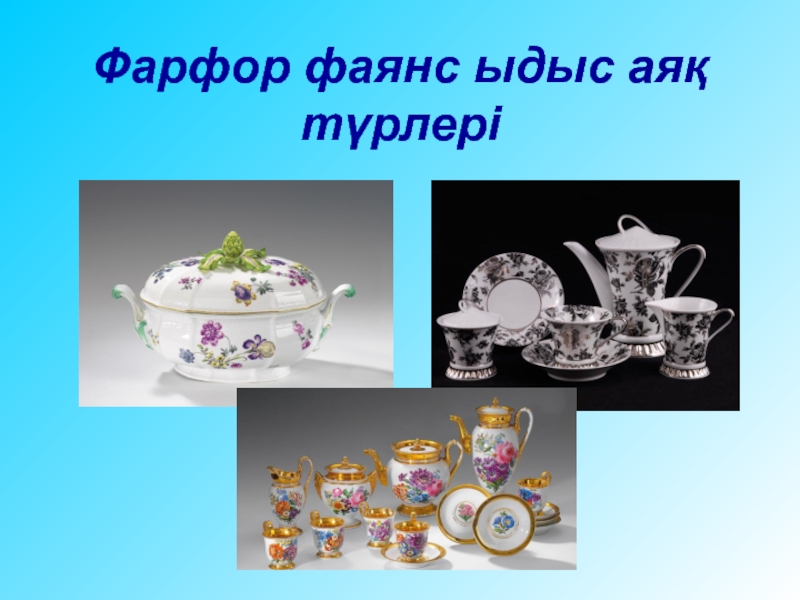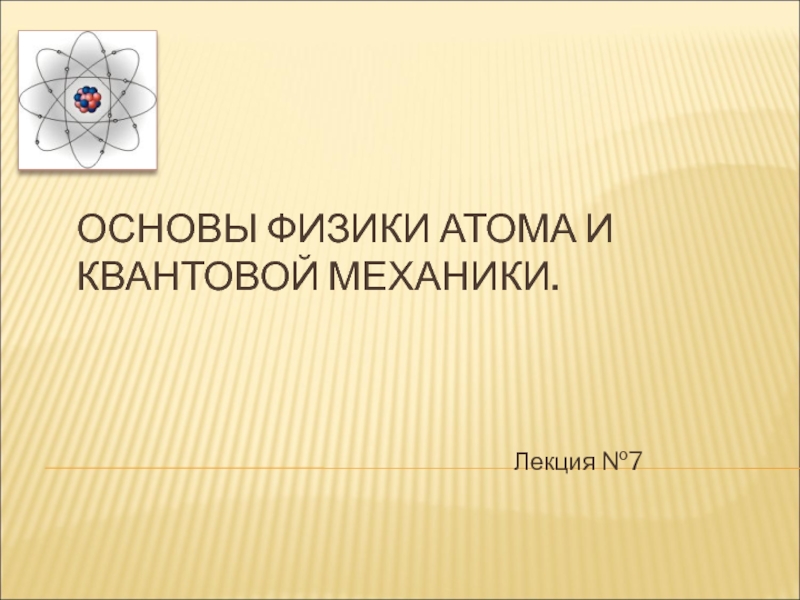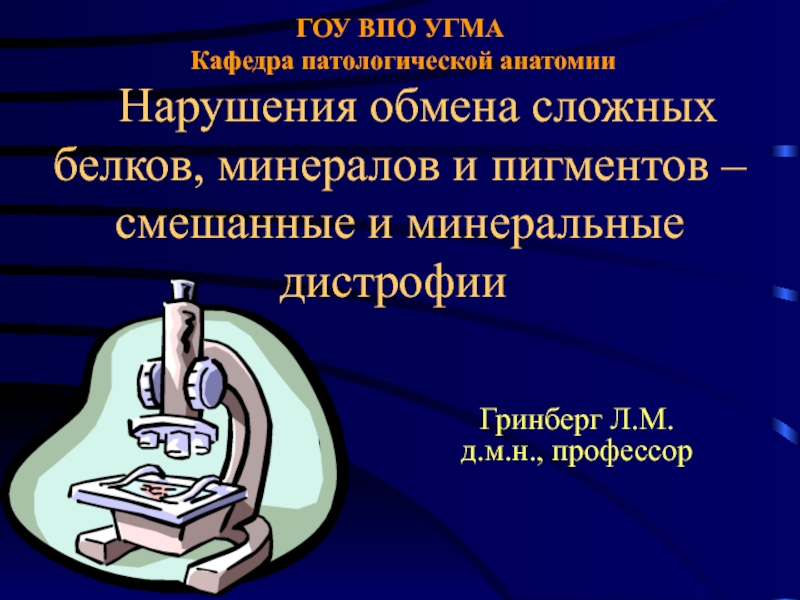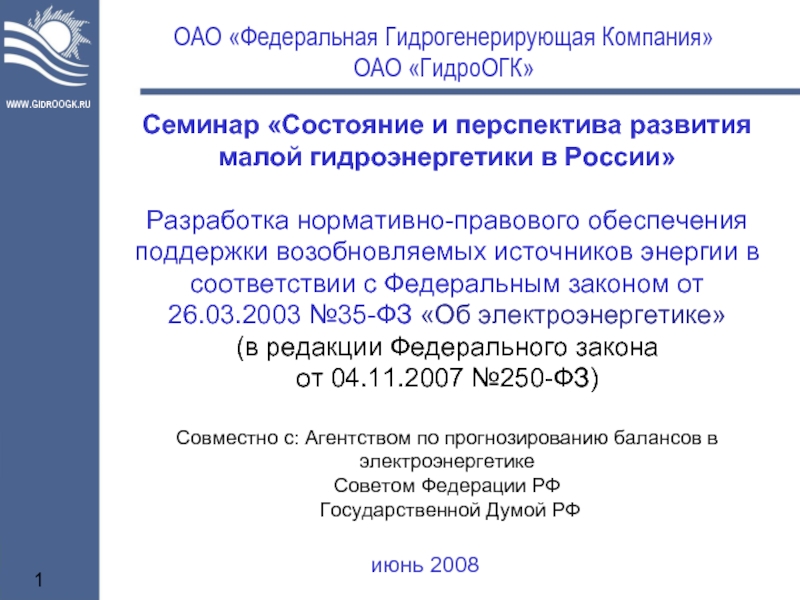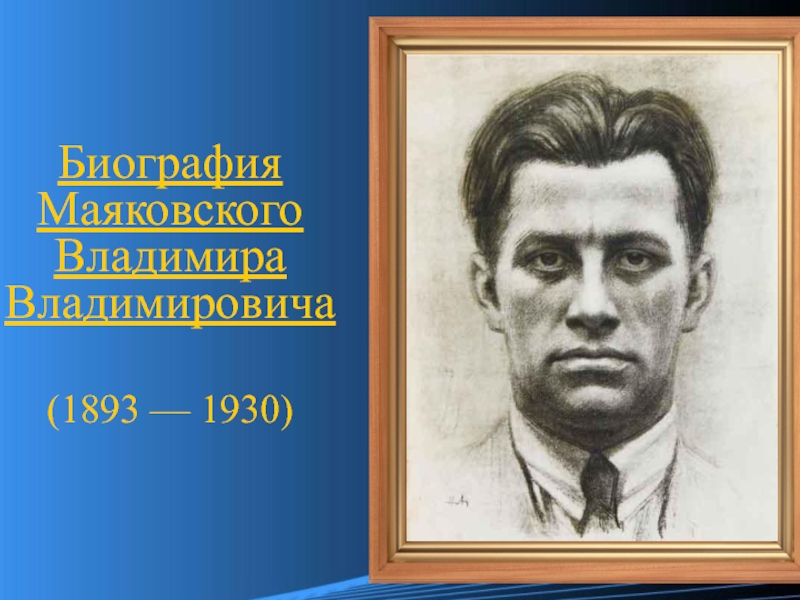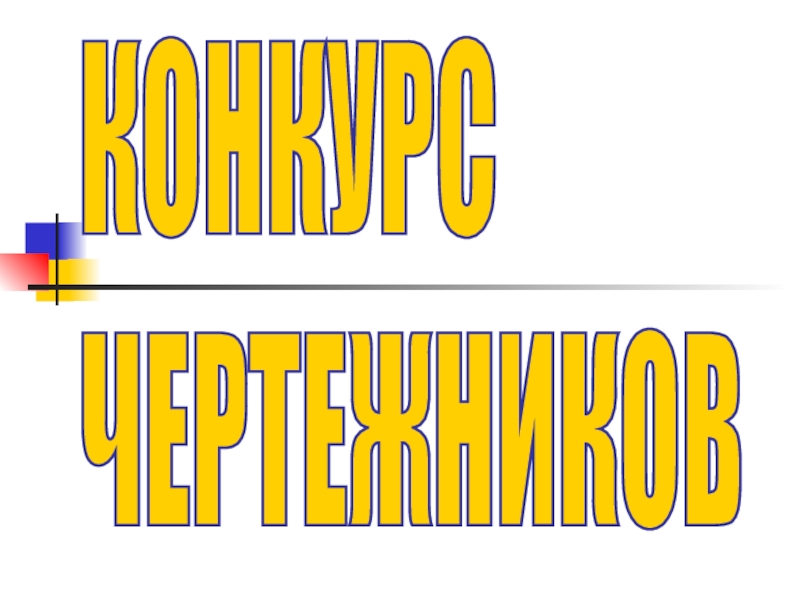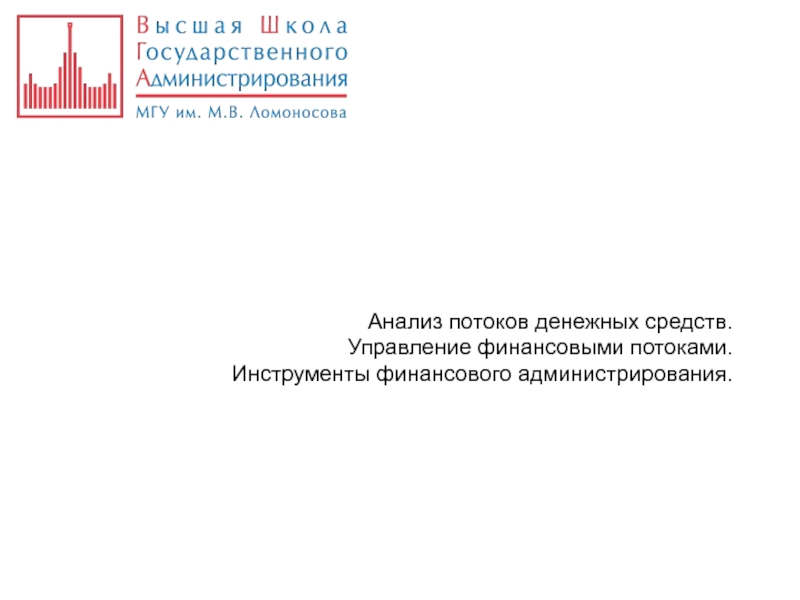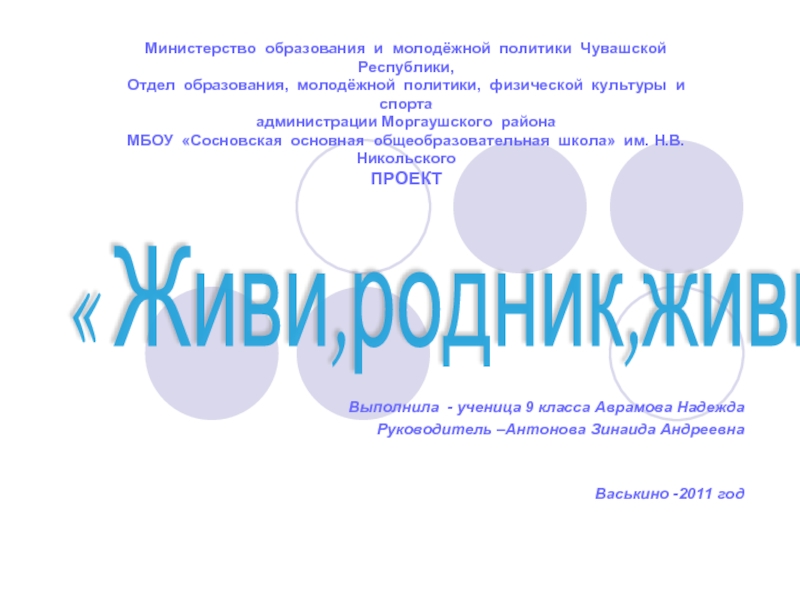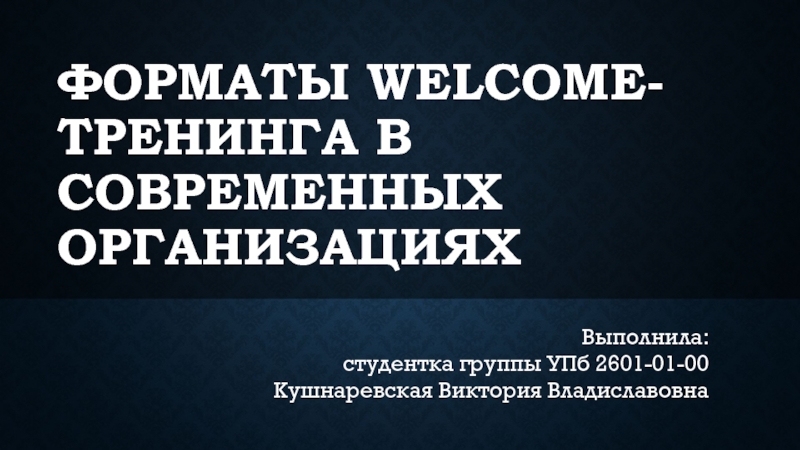Разделы презентаций
- Разное
- Английский язык
- Астрономия
- Алгебра
- Биология
- География
- Геометрия
- Детские презентации
- Информатика
- История
- Литература
- Математика
- Медицина
- Менеджмент
- Музыка
- МХК
- Немецкий язык
- ОБЖ
- Обществознание
- Окружающий мир
- Педагогика
- Русский язык
- Технология
- Физика
- Философия
- Химия
- Шаблоны, картинки для презентаций
- Экология
- Экономика
- Юриспруденция
Managing Operations
Содержание
- 1. Managing Operations
- 2. Copyright © 2010 Pearson Education, Inc. Publishing
- 3. Copyright © 2010 Pearson Education, Inc. Publishing
- 4. Copyright © 2010 Pearson Education, Inc. Publishing
- 5. Copyright © 2010 Pearson Education, Inc. Publishing as Prentice Hall18–Exhibit 18–1 The Operations System
- 6. Copyright © 2010 Pearson Education, Inc. Publishing
- 7. Copyright © 2010 Pearson Education, Inc. Publishing
- 8. Copyright © 2010 Pearson Education, Inc. Publishing
- 9. Copyright © 2010 Pearson Education, Inc. Publishing
- 10. Copyright © 2010 Pearson Education, Inc. Publishing
- 11. Copyright © 2010 Pearson Education, Inc. Publishing
- 12. Copyright © 2010 Pearson Education, Inc. Publishing as Prentice Hall18–Exhibit 18–3 Value Chain Strategy Requirements
- 13. Copyright © 2010 Pearson Education, Inc. Publishing
- 14. Copyright © 2010 Pearson Education, Inc. Publishing as Prentice Hall18–Benefits of Value Chain Management
- 15. Copyright © 2010 Pearson Education, Inc. Publishing
- 16. Copyright © 2010 Pearson Education, Inc. Publishing
- 17. Copyright © 2010 Pearson Education, Inc. Publishing
- 18. Copyright © 2010 Pearson Education, Inc. Publishing
- 19. Copyright © 2010 Pearson Education, Inc. Publishing
- 20. Copyright © 2010 Pearson Education, Inc. Publishing
- 21. Copyright © 2010 Pearson Education, Inc. Publishing
- 22. Copyright © 2010 Pearson Education, Inc. Publishing
- 23. Copyright © 2010 Pearson Education, Inc. Publishing
- 24. Copyright © 2010 Pearson Education, Inc. Publishing
- 25. Скачать презентанцию
Слайды и текст этой презентации
Слайд 2Copyright © 2010 Pearson Education, Inc. Publishing as Prentice Hall
18–
Learning
Outcomes Follow this Learning Outline as you read and study this
chapter.18.1 The Role of Operations Management
Define operations management.
Contrast manufacturing and services organizations.
Describe managers’ role in improving productivity.
Discuss the strategic role of operations management.
18.2 What Is Value Chain Management and Why Is It Important?
Define value chain and value chain management.
Describe the goal of value chain management.
Describe the benefits of successful value chain management.
Слайд 3Copyright © 2010 Pearson Education, Inc. Publishing as Prentice Hall
18–
Learning
Outcomes
18.3 Managing Operations by Using Value Chain
Management• Discuss the requirements for successful value chain
management.
• Explain the obstacles to value chain management.
18.4 Current Issues in Operations Management
Discuss technology’s role in manufacturing.
Explain ISO 9000 and Six Sigma.
Describe mass customization and how operations management contributes to it.
Слайд 4Copyright © 2010 Pearson Education, Inc. Publishing as Prentice Hall
18–
What
Is Operations Management?
Operations Management
The design, operation, and control of the
transformation process that converts such resources as labor and raw materials into goods and services that are sold to customers.The Importance of Operations Management
It encompasses both services and manufacturing.
It is important in effectively and efficiently managing productivity.
It plays a strategic role in an organization’s competitive success.
Слайд 5Copyright © 2010 Pearson Education, Inc. Publishing as Prentice Hall
18–
Exhibit
18–1 The Operations System
Слайд 6Copyright © 2010 Pearson Education, Inc. Publishing as Prentice Hall
18–
Manufacturing
and Services
Manufacturing Organizations
Use operations management in the transformation process of
turning raw materials into physical goods.Service Organizations
Use operations management in creating nonphysical outputs in the form of services (the activities of employees interacting with customers).
Слайд 7Copyright © 2010 Pearson Education, Inc. Publishing as Prentice Hall
18–
Managing
Productivity
Productivity
The overall output of goods or services produced divided by
the inputs needed to generate that output.A composite of people and operations variables.
Benefits of Increased Productivity
Economic growth and development
Higher wages and profits without inflation
Increased competitive capability due to lower costs
Слайд 8Copyright © 2010 Pearson Education, Inc. Publishing as Prentice Hall
18–
Exhibit
18–2 Deming’s 14 Points for Improving
Productivity
Plan
for the long-term future.Never be complacent concerning the quality of your product.
Establish statistical control over your production processes and require your suppliers to do so as well.
Deal with the best and fewest number of suppliers.
Find out whether your problems are confined to particular parts of the production process or stem from the overall process itself.
Train workers for the job that you are asking them to perform.
Raise the quality of your line supervisors.
Drive out fear.
Encourage departments to work closely together rather than to concentrate on departmental or divisional distinctions.
Do not adopt strictly numerical goals.
Require your workers to do quality work.
Train your employees to understand statistical methods.
Train your employees in new skills as the need arises.
Make top managers responsible for implementing these principles.
Source: W.E. Deming, “Improvement of Quality and Productivity Through Action by Management,” National Productivity Review, Winter 1981–1982, pp. 12–22. With permission. Copyright 1981 by Executive Enterprises, Inc., 22 West 21st St., New York, NY 10010-6904. All rights reserved.
Слайд 9Copyright © 2010 Pearson Education, Inc. Publishing as Prentice Hall
18–
Strategic
Role of Operations Management
The era of modern manufacturing began in
the U.S. over 100 years ago.After WWII, U.S. manufacturers focused on functional areas other than manufacturing.
By the 1970’s, foreign competitors integrated manufacturing technologies were producing quality goods at lower costs.
U.S manufacturers responded by investing in updated technology, restructuring organizations, and including production requirements in their strategic planning.
Слайд 10Copyright © 2010 Pearson Education, Inc. Publishing as Prentice Hall
18–
Value
Chain Management
Value
The performance characteristics, features and attributes, and any other
aspects of goods and services for which customers are willing to give up resources (i.e., spend money).The Value Chain
The entire series of organizational work activities that add value at each step beginning with the processing of raw materials and ending with the finished product in the hands of end users.
Слайд 11Copyright © 2010 Pearson Education, Inc. Publishing as Prentice Hall
18–
Value
Chain Management (cont’d)
What is Value Chain Management?
The process of managing
the entire sequence of integrated activities and information about product flows along the entire value chain.Goal of Value Chain Management
To create a value chain strategy that fully integrates all members into a seamless chain that meets and exceeds customers’ needs and creates the highest value for the customer.
Слайд 12Copyright © 2010 Pearson Education, Inc. Publishing as Prentice Hall
18–
Exhibit
18–3 Value Chain Strategy Requirements
Слайд 13Copyright © 2010 Pearson Education, Inc. Publishing as Prentice Hall
18–
Value
Chain Management (cont’d)
Requirements for Value Chain Management
A new business model
incorporating:Coordination and collaboration
Investment in information technology
Changes in organizational processes
Committed leadership
Flexible jobs and adaptable, capable employees
A supportive organizational culture and attitudes
Слайд 14Copyright © 2010 Pearson Education, Inc. Publishing as Prentice Hall
18–
Benefits
of Value Chain Management
Слайд 15Copyright © 2010 Pearson Education, Inc. Publishing as Prentice Hall
18–
Exhibit
18–4 Obstacles to Successful Value Chain
ManagementСлайд 16Copyright © 2010 Pearson Education, Inc. Publishing as Prentice Hall
18–
Value
Chain Management (cont’d)
Obstacles to Value Chain Management
Organizational barriers
Refusal or reluctance
to share informationReluctance to shake up the status quo
Security issues
Cultural attitudes
Lack of trust and too much trust
Fear of loss of decision-making power
Required capabilities
Lacking or failing to develop the requisite value chain management skills
Слайд 17Copyright © 2010 Pearson Education, Inc. Publishing as Prentice Hall
18–
Value
Chain Management
Obstacles to Value Chain Management (cont’d)
People
Lacking commitment to do
whatever it takesRefusing to be flexible in meeting the demands of a changing situation
Not being motivated to perform at a high level
Lack of trained managers to lead value chain initiatives
Слайд 18Copyright © 2010 Pearson Education, Inc. Publishing as Prentice Hall
18–
Current
Issues in Managing Operations
Technology’s Role in Manufacturing
Increased automation and
integration of production facilities with business systems to control costs.Predictive maintenance, remote diagnostics, and utility cost savings
The Concept of Quality
The ability of a product or service to reliably do what it’s supposed to do and to satisfy customer expectations.
Слайд 19Copyright © 2010 Pearson Education, Inc. Publishing as Prentice Hall
18–
Current
Issues in Managing Operations
Quality Initiatives
Planning for quality
Organizing and leading
for qualityControlling for quality
Quality Goals
ISO 9000 certification
Six Sigma standards
Слайд 20Copyright © 2010 Pearson Education, Inc. Publishing as Prentice Hall
18–
Exhibit
18–5 Product Quality Dimensions
Performance—Operating characteristics
Features—Important special characteristics
Flexibility—Meeting operating specifications over
some period of timeDurability—Amount of use before performance deteriorates
Conformance—Match with preestablished standards
Serviceability—Ease and speed of repair or normal service
Aesthetics—How a product looks and feels
Perceived quality—Subjective assessment of characteristics (product image)
Sources: Adapted from J.W. Dean, Jr., and J.R. Evans, Total Quality: Management, Organization and Society (St. Paul, MN: West Publishing Company, 1994); H.V. Roberts and B.F. Sergesketter, Quality is Personal (New York: The Free Press, 1993): D. Garvin, Managed Quality: The Strategic and Competitive Edge (New York: The Free Press, 1988); and M.A. Hitt, R.D. Ireland, and R.E. Hoskisson, Strategic Management, 4th ed. (Cincinnati, OH: SouthWestern, 2001), p. 211.
Слайд 21Copyright © 2010 Pearson Education, Inc. Publishing as Prentice Hall
18–
Exhibit
18–5 (cont’d) Service Quality Dimensions
Timeliness—Performed in promised period of time
Courtesy—Performed cheerfully
Consistency—Giving
all customers similar experiences each timeConvenience—Accessibility to customers
Completeness—Fully serviced, as required
Accuracy—Performed correctly each time
Sources: Adapted from J.W. Dean, Jr., and J.R. Evans, Total Quality: Management, Organization and Society (St. Paul, MN: West Publishing Company, 1994); H.V. Roberts and B.F. Sergesketter, Quality is Personal (New York: The Free Press, 1993): D. Garvin, Managed Quality: The Strategic and Competitive Edge (New York: The Free Press, 1988); and M.A. Hitt, R.D. Ireland, and R.E. Hoskisson, Strategic Management, 4th ed. (Cincinnati, OH: SouthWestern, 2001), p. 211.
Слайд 22Copyright © 2010 Pearson Education, Inc. Publishing as Prentice Hall
18–
Current
Issues in Managing Operations
Mass Customization
Is a design-to-order concept that
provides consumers with a product when, where, and how they want it.Makes heavy use of technology (flexible manufacturing techniques) and engages in a continual dialogue with customers.
Benefits of Mass Customization
Creates an important relationship between the firm and the customer in providing loyalty-building value to the customer and in garnering valuable market information for the firm.
Слайд 23Copyright © 2010 Pearson Education, Inc. Publishing as Prentice Hall
18–
Terms
to Know
operations management
manufacturing organizations
service organizations
productivity
value
value chain
value chain management
organizational processes
RFID
intellectual property
quality
ISO
9000Six Sigma
mass customization
Cellular manufacturing
